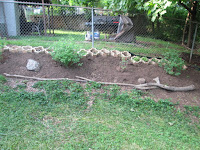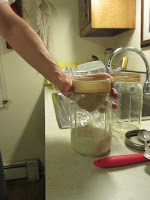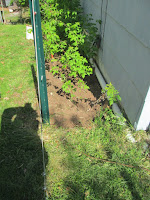I recently discovered a new group on Reddit: Eat Cheap and Healthy. It's not specifically about vegan or vegetarian cooking, but given that meatless dishes tend to be both cheaper and healthier than meaty ones, this board is a pretty good place to find them. In my very first day of browsing there, I came across a post that enthusiastically recommended the red lentil pasta sauce from Kitchen Treaty, saying it was both delicious and "very flexible if you want to make changes based on what you have around."
This piqued my interest, since we've had a jar of red lentils sitting on our shelf for years (fourth from the left in the picture at the top of the page) and haven't done a lot with them. We bought them to make the curried red lentil soup from The Clueless Vegetarian, which is pretty good, but we got tired of it after a while and didn't know what else to use the lentils for.
I showed the recipe to Brian, and he noted that we already had most of the necessary ingredients to make this dish with a few tweaks. We didn't have any canned fire-roasted tomatoes, but the recipe noted that plain whole tomatoes would also work in a pinch. We figured we could safely substitute a yellow bell pepper, which we had on hand, for the green bell pepper the recipe called for and use sherry in place of the red wine. We could easily whip up a vegetable broth (if not technically a low-sodium one) with our trusty Penzey's vegetable stock. And while we didn't have Italian seasoning in the spice cupboard, we had all the necessary components (three parts basil, two parts oregano, one part thyme, and one part rosemary) to whip up a quick DIY version.
The recipe was simple enough to make, but Brian found the instructions a little questionable. They said to simmer the sauce for 25 minutes "or until the lentils are tender," but they were nowhere near tender at the 25-minute mark. He let it go another 10 minutes and they were still a little on the crunchy side.
Aside from that, though, the sauce was quite satisfying. It had the flavor you'd expect from a traditional ragu-style sauce, but the texture was more interesting, with the diced carrot adding a chunkiness most pasta sauces don't have. The red lentils themselves didn't contribute in a noticeable way to the sauce's flavor, but they gave it a surprisingly meaty texture. You could probably feed this dish to a meat-eater who wasn't particularly observant and they would never realize it was vegetarian, much less vegan. (Brian used sugar instead of honey to ensure it would fit that bill.)All in all, we both like this sauce and think it's a worthy addition to our dinner repertoire. Next time, Brian plans to try preparing it in the pressure cooker, which should cut down on the cooking time. He figures he can just saute the veggies in the pot, then add the rest of the ingredients and give it about 10 minutes at full pressure. If that works, the sauce will only take about 20 minutes in total to prepare, which means it can be ready in the time that it takes to heat the water and cook the pasta.
With that adjustment, this will be just about everything we could ask for in a dinner dish: quick, easy, cheap, tasty, vegan, and possible to make from ingredients we almost always have on hand. It's the perfect sort of recipe to have tucked away in your files for those nights when there's nothing in the fridge.












